Last weekend brought a surprise – snowy rooftops. The white stuff melted fast, but the chilly air remained. Down at the apiary the ground was hard and all was quiet, with no bees flying.
When the bees are tucked up, the varroa boards provide a clue to the size and position of the cluster. The white flakes are particles of wax dropped by the bees as they uncap honey stores to feed. The dark brown oval shapes are varroa mites killed by oxalic acid trickling.
Each board tells a different story – some of the clusters are small and tight, others cover several frames. We have taken the boards out now as it’s not a good idea to leave them in all the time. This way the bees have ventilation at the bottom and plenty of insulation at the top, thanks to Tom’s specially built insulated roofs plus insulation foil from Wickes which we pack over the crown boards.
I checked the hive entrances and discovered that Melissa’s mouseguard had somehow come undone and fallen down on one side, leaving the entrance open. I put it back in place with extra drawing pins; hopefully I wasn’t trapping a mouse inside!
At this time of year I wish I could spend my winter huddling inside like the bees. I don’t enjoy my winter commute – leaving for work and coming home from work in the dark, waiting at chilly bus stops.
The solution? A nice cup of tea. This lovely ‘Bee puffer mug‘ by Lush Designs was one of my Christmas pressies.
I can put my bee mug down on a bee coaster from Chickidee too, another lovely Christmas present. Finding bee-themed baby clothes is my next mission 🙂

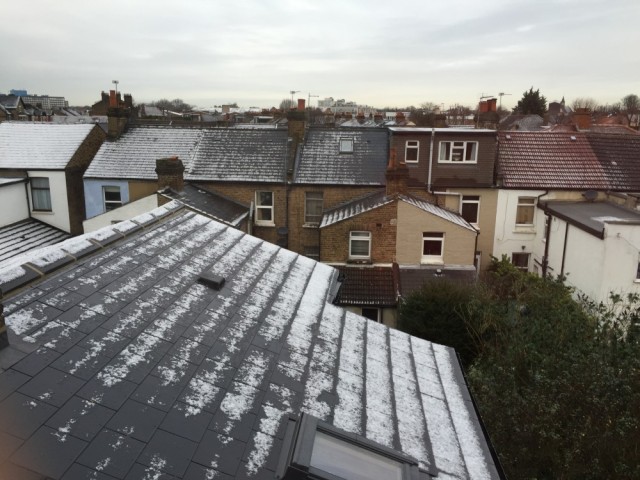
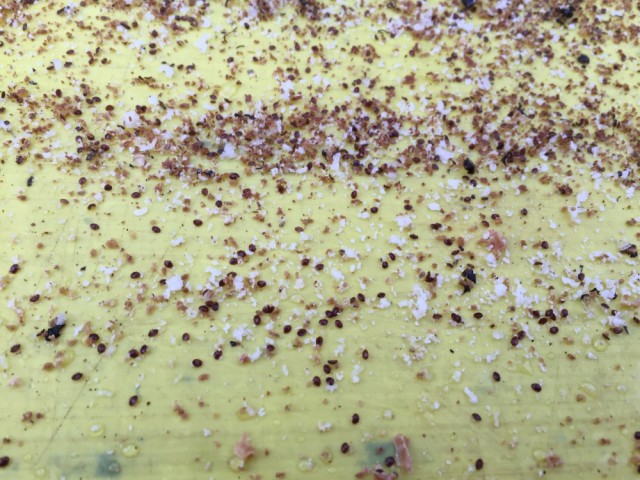
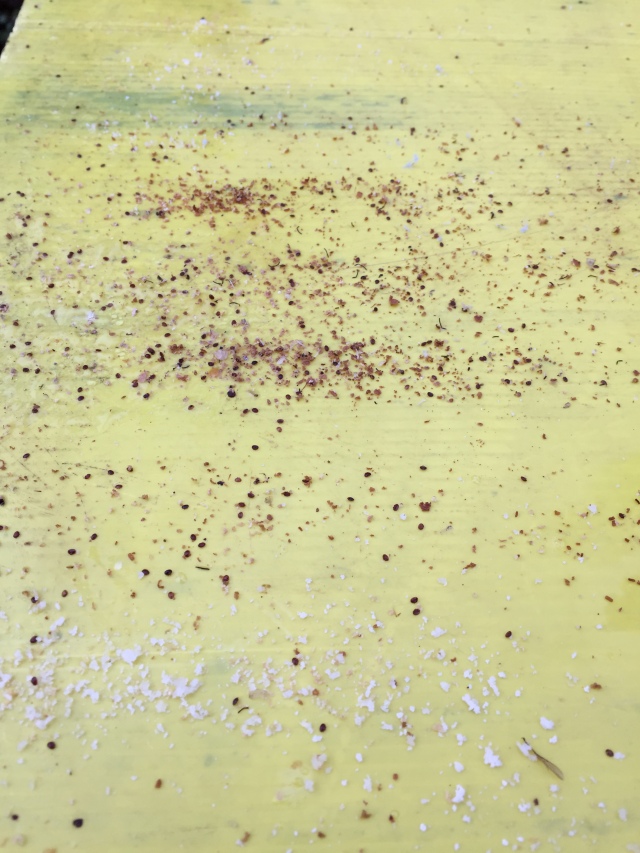


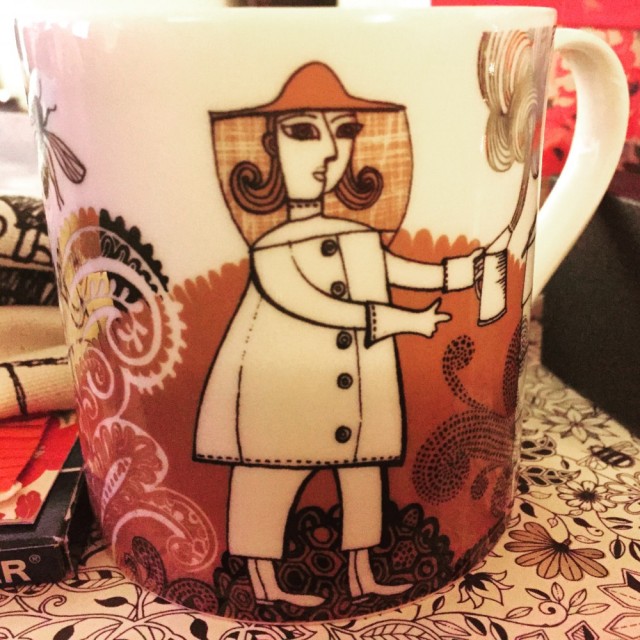
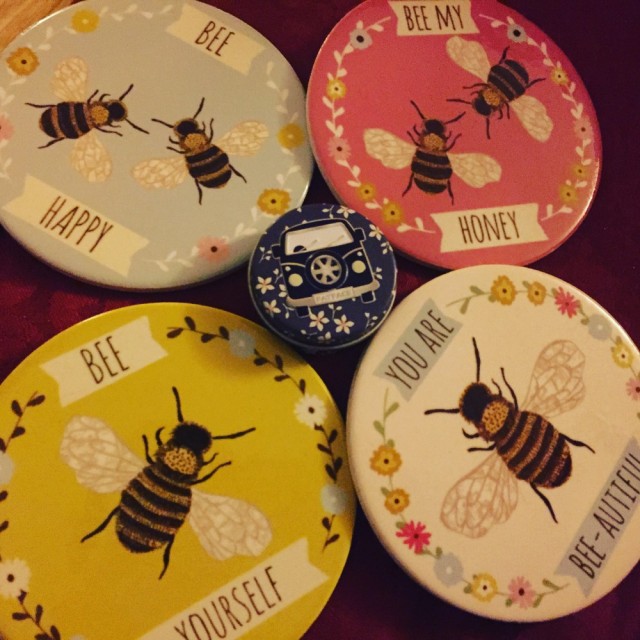
We had snow last weekend and it’s not got above about 5’C all week. We moved our bees to their new apiary, apart from one pair as it had got dark and was snowing by the time we’d moved ours.
We strapped a ladder to the top of the hive and lifted them with that. It worked really well but my elbow hurt after one so someone took over from us at the front. In theory four of us could have held a corner of the ladder each. It kept the hives really level. Was too cold to take a photo!
LikeLiked by 1 person
Hi Di, that sounds like a tricky move! Impressed by your ingenious ladder method. Hope they like their new location.
LikeLiked by 1 person
I hope so too. It’s shadier than where they’ve been, but we didn’t have a choice. .. It will be interesting to see whether it delays swarming and build up.
LikeLike
5°C that is almost summer…. We have had -10°C at night and not rising above -2°C in the daytime. Now that is really cold. If I didn’t have dogs that need to go out and actually love snow…..I would probably cluster in the living room all day too. We still have to move our hives to their new location as well. The ground was too wet to drive the car anywhere near to where they are now, but frozen like in the last couple of weeks has it’s own dangers. Good luck Diana with the move.
LikeLike
Oof. Those dogs must have tough paws. Hope you and the bees can get through it ok.
LikeLike
I’ve got mitey bees now despite treating them last fall. I think since the warm weather lasted so long they had more time to go out and get reinfected. Wish we had the warm opportunities you do to hit them with oxalic acid.
LikeLike
The Apiarist did an interesting post recently, using a special simulation program called BEEHAVE to model the effects of mite treatments at different times of the year: http://theapiarist.org/time-to-beehave/
The results found that one treatment is better than nothing, but “It’s only when you combine early autumn and midwinter treatments that mite numbers are really well controlled.” At least your cold weather will keep brood levels down and stop the mites reproducing. It doesn’t need to be warm to treat with oxalic acid, as the more tightly clustered they are the easier trickle treatment is. If you feel it’s too cold to open the hive, maybe vaporisation would be a better option… but I appreciate that the equipment can be expensive.
LikeLiked by 1 person
Our bees are very lively at the moment and K decided to treat them with HiveClean but only got a drop of 1 a day which is what I would have considered a normal for this time of year and not post treatment. I have the feeling they think it is springtime already. Poor confused girls! Amelia
LikeLike
That is a great drop Amelia, wish ours was so low. What percentage efficiency (kill rate) does HiveClean have? Oxalic acid on a broodless colony is meant to achieve over 90% dead mites, whereas I haven’t seen HiveClean’s efficiency rate mentioned anywhere before. But with a drop like that I wouldn’t be worrying anyway.
LikeLike
In their literature they talk of a nearly 100% efficiency for three consecutive (almost weekly) treatments. K went for it as it is supposed to be gentle and we do not feel the bees are broodless. Still, I would have expected a higher drop if any treatment had been used.
LikeLike
I like the plates 🙂
LikeLiked by 1 person
Baby clothes are the best! When they grow up you get less of a say in picking out their clothes. Perhaps something like this: http://www.amazon.co.uk/Flannel-Pajamas-Cosplay-Sleepwear-Nightwear/dp/B014IEPU6W. I even went to the UK site just for you 🙂
In the U.S., we just got pummelled with a couple feet of snow yesterday and today (actually, it’s still snowing out there). We are definitely clustered in our homes. I was planning for an OA treatment this weekend, as our mite drop is 4 in one hive and 6 in the other. A bit too much snow to make this happen right now, perhaps next weekend depending on the melt….
LikeLike
Love that baby suit, thank you! Hoping you get a thaw soon, a couple of feet is unimaginable here. Very sensible to stay clustered inside.
LikeLiked by 1 person
Here we had a day or so of winter and now its back to the wet mild weather, mustn’t complain though.
LikeLike
Yes, seeing the extreme weather other people are going through around the world does make me feel grateful for our mild climate. We have been lucky in London to escape the flooding too.
LikeLike
And within days the sun is shining and the bees are flying again!
Check out this cute bee baby t shirt: https://www.omlet.co.uk/shop/gifts/tiny_tots_clothing/15921/perdie_%26_boo_bee_t-shirt_6_%E2%80%93_12_months/?rf=7432e9f0e980e0c9ea4d3f884178268e
Sara x
LikeLike
I love it! On my to-buy list for sure, thanks Sara!
LikeLike
Very cool coffee cup. Do you always remove the Varroa mite board in winter? I’m interested to know what are the pro’s and con’s. I remove mine in summer and keep it on in winter because I think it helps the bees to regulate the temperature in the hive when it’s really cold out. I’m still new in this and it’s still trial and error for me.
LikeLike
We do always try to remove the boards and only leave them in for a week each time we monitor the mite drop. This is for ventilation and also because if you leave the boards in, any live mites that fell down from the bees grooming will be able to climb back up into the colony rather than falling through the mesh floor. That’s the theory anyway – I haven’t sat and watched them make the journey back up!
LikeLiked by 1 person
I have a screened bottom board so the mites fall through the screen on to the corrugated sheet (with a grid printed on) below. I coated the sheet with either Vaseline or vegetable oil so the mites will stick to the sheet. I only keep the sheet on during late autumn until spring to help the bees stay warm. I remove it in summer so the hive gets more air flow and the mites would fall through to the ground. At least that’s the plan.
LikeLike
The vaseline to help the mites stick is a good idea.
LikeLike
It must be a relief to the bees to be mite-free, if only for a while. Happy baby clothes shopping-there’s so much gorgeous stuff out there!
LikeLike
Thanks, there is indeed!
LikeLike
I love those lush cushion beekeeping designs and the bee mugs and coasters are perfect for all that tea we need to drink right now!
LikeLike
Yes, there are some lovely bee designs out there at the moment if you can sneak them past John 😉
LikeLiked by 1 person